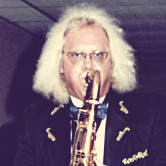Soprano Saxophone and Intonation
Paul R. Coats
“Soprano saxes have intonation problems…” True, but so do most musical instruments. I will show you how to minimize these problems in the following paragraphs.
All saxophones have similar inherent intonation tendencies, but they show up more noticably on soprano saxophone for a number of reasons. Any slight change in embouchure tension will cause a greater change in pitch than is to be expected by the experienced alto or tenor saxophonist.
A mouthpiece of medium chamber volume and tip opening will give the best results. The Runyon Custom mouthpiece, with #5 to #7 facing (.050″ to .060″ tip opening), will give good results for most players. Try these tip openings with #2 1/2 to #3 reeds. This mouthpiece has exceptionally good response in the palm key range.
The biggest problem to overcome is the tendency to play with improper embouchure tension. If playing with too little tension, the mouthpiece must be pushed onto the neck cork too far in order to tune to Concert A or Bb. The palm keys will be sharp and the low notes flat.
Too much embouchure tension will require the mouthpiece to be placed too far out on the cork. The palm key notes will be flat, and probably choke off when the player attempts to lip them up to pitch. Notes on the other end of the sax will be sharp. The tone will be strident.
Here is the easiest way to find the proper embouchure tension. Playing the mouthpiece and reed only, the player should produce a concert Db, two octaves and a half step above middle C on the piano. Blow the mouthpiece/reed repeatedly until this pitch can be produced consistently. This method of blowing particular pitches with each mouthpiece of the single reed family is outlined in Santy Runyon’s “Suggestions for Woodwind Players”.
Now place the mouthpiece on the instrument. Using a good tuner (at A = 440 hz reference), tune the soprano’s middle C to concert Bb. Mark the cork lightly with a pencil. Remove the mouthpiece and recheck the embouchure tension by blowing the concert Db. Replace the mouthpiece on the cork and check the middle C tuning note again. Concentrate on using the same embouchure tension as when blowing the concert Db on the mouthpiece only. (Some bands and orchestras tune higher than A = 440. This can only cause problems as modern instruments are designed to play at A = 440.)
Play up and down the scale and check the pitch of each note with the tuner. Do not lip notes into tune, but just observe which notes are sharp or flat, and by how much. Every so often remove the mouthpiece and check the embouchure tension by blowing the concert Db.
Check the tuning of middle C and upper C. Check low register A and upper A. Find the mouthpiece position that is the best compromise for these notes. Do not lip them into tune. Play them all with the same embouchure tension. When the best mouthpiece position is found, mark the cork with a pen for future tuning reference.
Make sure the octave key is fully depressed for upper register C#. This is necessary so that the lower half of the aperture assembly will close fully. A cork or plastic wedge may be glued (using E6000 craft glue) to the octave key to aid operation of this key.
Do not “bite” for the palm key notes. These high notes are aided by slightly raising the tongue position, thus reducing the oral cavity volume and increasing airstream velocity. Begin this oral cavity alteration at high C or C#, and increase it gradually as you ascend to higher pitches.
On some soprano saxes leave the D palm key closed for high Eb through F#. This is the advantage of having independent palm keys. If palm key notes are still sharp, have these pad openings checked and possibly reduced.
If the middle C (concert Bb) tuning note is in tune but both the lower and upper register A’s are sharp, the G pad may be opening too far. This pad’s opening is controlled by a cork on the linkage just over the lower octave vent on the side of the sax. The octave vent pad and the cork on the linkage above it may have settled in and compressed. Have a thicker cork put in to reduce the G pad’s opening to the proper setting.
Do not drop the jaw for low notes. If low notes do not respond easily, “dope” the pads, or have a repairman check the instrument with a leak light. Also check that the G# pad does not crack open when fingering low C#, B, or Bb. If it does, adjust the G# closure.
When playing a straight soprano sax, hold the body out at about 30 to 45 degrees below horizontal. Do not hold it close to the body like a clarinet (unless playing a curved neck). The mouthpiece should enter the mouth at about the same angle as an alto saxophone mouthpiece. Holding the soprano sax in a near vertical angle will cause the tone to be choked off and likely to “warble” in the low register.
If the above suggestions are followed, the soprano saxophone may be played as well in tune as the other members of the saxophone family.


